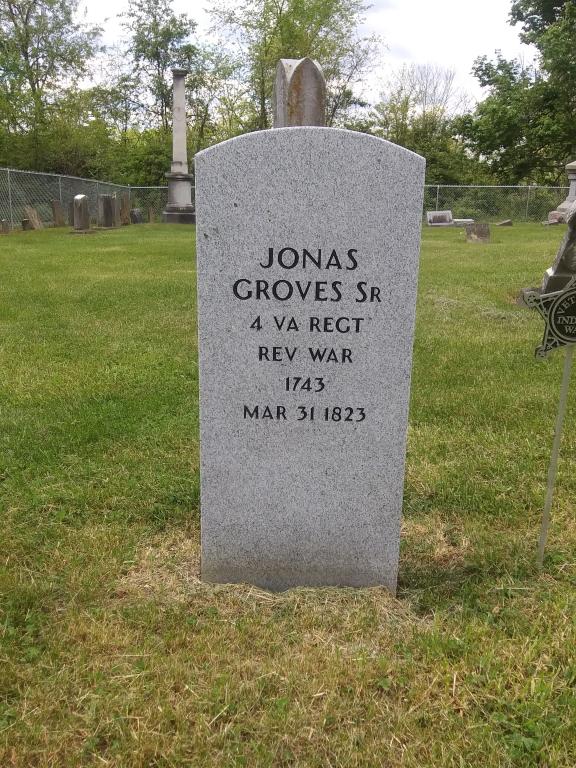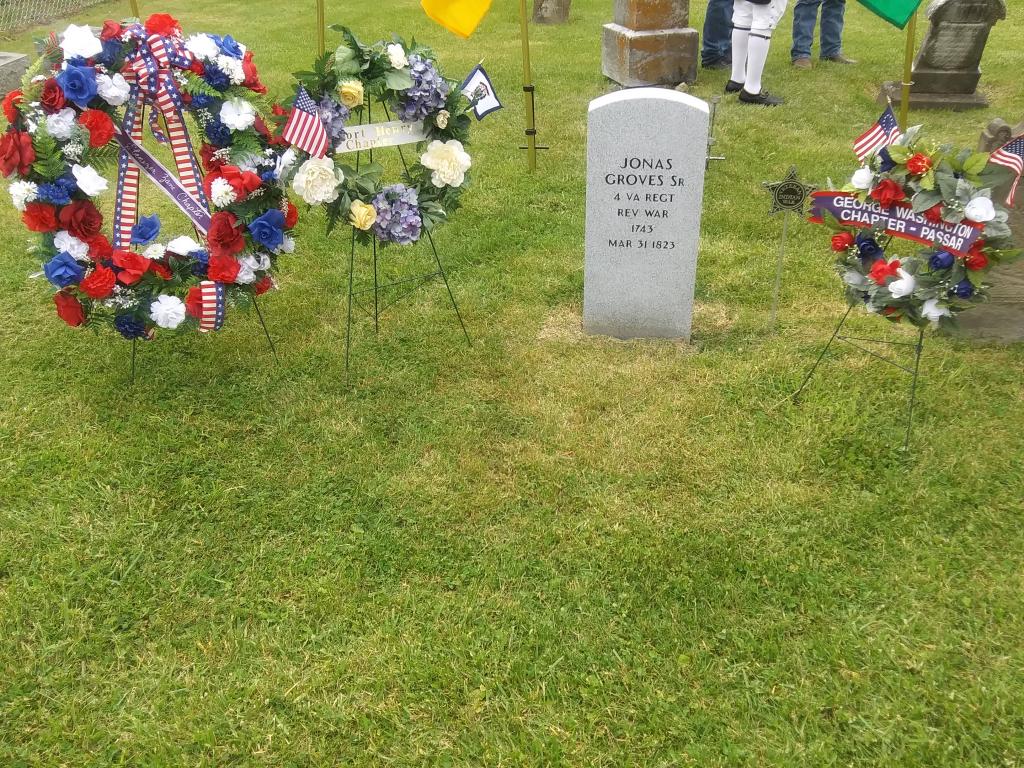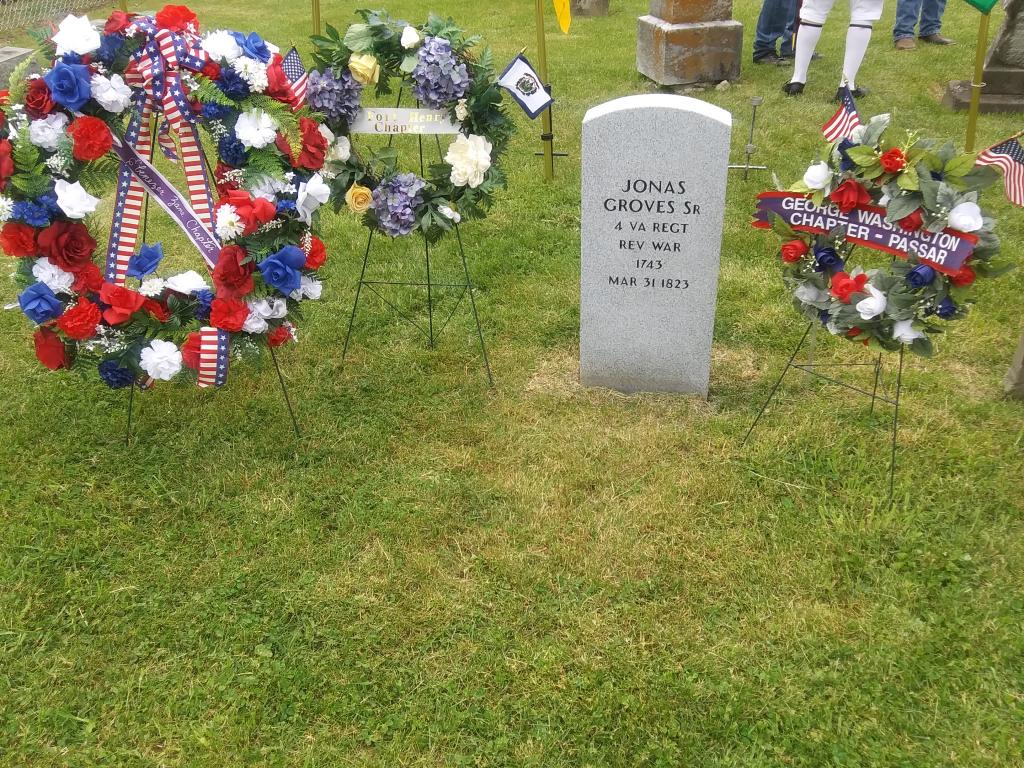Author: Aaron R. Dodds
A Forgotten Forefather – by Aaron R. Dodds
***This biography of Jonas Groves, Sr. originally appeared at:
https://historysbackpages.blogspot.com/2011/06/forgotten-forefather.html#more
and is published with consent of the author.***
Throughout the course of time there have been a countless number of men that have performed tasks of great distinction and are forever remembered in the annals of history, yet there are even more men who have perform just as nobly and have all but been forgotten. Many of these forgotten men laid the very footing of the civilization that we live in today. Moreover, many of us can call them our ancestors, they are the roots of which we derive from; a thread in our lives’ fabrics, and an unknown moral compass within us. This is the story of one of these men. This is the story of Jonas Groves.
In researching the life of Jonas Groves, it quickly becomes apparent that much of his life is still submerged in the murky waters of history, yet to surface to the modern researcher. However, the story of his life that is known is that quite full of merit and well worth recording in the annuals of history. What is known is that Jonas Groves was born in 1743, and at the age of seventeen volunteered for service in the French and Indian War. He enlisted in 1761 with Major Robert Rogers and his Rangers, and quickly became one of the feared scouts.
Roberts’ Rangers were a fierce bunch of backwoods pioneers who fought for the British Crown against the French and Indians in the northwest frontier of the Great Lakes region. They were well known as being one of the only combatant groups, besides Indians, that could function in theses harsh terrains and harsher winters. Major Roberts led his Rangers on many raids in the dead of winter against French towns and encampments, using primitive snowshoes and walking across frozen lakes and rivers.
On February 10, 1763, the Treaty of Paris was signed by France and England ultimately ending formal warfare between the two countries and bringing the seven year French and Indian War to a close. As part of the surrender terms the French were to relinquish Fort Detroit over to British control, and Major Roberts and his Rangers were assigned the task of taking control of the fort and supplying it.
Jonas Groves was sent to Buffalo, New York, along with several other Rangers to gather supplies and ferry them across Lake Erie to Fort Detroit. On May 30, 1763, while Jonas and 117 other Rangers were ferrying supplies in open boats to Fort Detroit they were attacked by a large band of Ottawa Indian warriors. Although they were twenty-five miles from the fort and in open water, they were surprised and ambushed, suffering heavy casualties. Of the one hundred and eighteen men on the lake, only eight Rangers, including Jonas Groves, survived and were taken captive.
One of the reasons that Jonas and his fellow Rangers were caught off guard, was that as far as they knew all hostilities were concluded. Little did they know that the Ottawa Chief Pontiac was furious of the way that British General Jeffery Amherst was handling Indian relations after the war, and got several different tribes of Indians from the Great Lake Region and Illinois and Ohio Country to band together and strike heavy blows against the British at the frontier forts. Thus on May 7, 1763, while Jonas was out on Lake Erie, Pontiac and his allies struck their first blow against Fort Detroit and the men bringing supplies to them. They were effective in many aspects because they had a profound knowledge of the area surrounding the fort, since only months before they used it as their own along with their French allies. However, Fort Detroit did not fall that night and the Indians waged a siege for several months against the stronghold.
Meanwhile, on that eventful night of May 30, Jonas was hauled off with the seven remaining survivors of the ambush. They were dragged to the Indian camp in Detroit, where in the ensuing hours all of the men tortured and with the exception of Jonas, were mutilated and executed. Their bodies were then thrown into the river so they would float by the fort and lower moral and possibly provoke surrender of the fort by the British. Jonas was spared death after being rescued by an Indian squaw. He was then “adopted,” transferred, to a Chippewa tribe where he remained for eighteen months. Jonas was purchased by a cunning French trader for 100 French livres, and then taken to Montreal. At Montreal, Jonas was taken to English authorities where he was traded for a land grant of 1000 acres. However, although the French trader made out in the bargain, Jonas did not fare so well. Although he was essentially freed from his year and a half captivity, his Army superiors felt he needed to pay back some of the cost for his freedom. Therefore, although his three year term of enlistment had expired, Jonas was forced to serve out an additional four years, as part of a seven year enlistment, at Fort Niagara.
Upon the conclusion of his service, Jonas moved to Warm Springs, Berkley County, (West) Virginia. Here he picked up the trade of butcher and remained in this service until 1778, when again a sense of duty to his country overcame him and Jonas enlisted in the military. However, this time instead of fighting for the Crown, he fought against it.
Jonas enlisted as a private for three months service in Captain Mathias Ambrose Company serving in Colonel Pendleton’s Regiment. When this term expired he reenlisted in Captain John Steed’s Company of Colonel Neville’s Regiment of the Fourth Virginia Continental Line. His term of enlistment was for one year, and he joined the main army in their winter encampment at Valley Forge. When the regiment fought at the Battle of Monmouth, Jonas was bedridden in an army hospital; however, he recovered a few months later. He began to pull twice the duty serving as a regular private and a butcher for the regiment. Jonas did not have that quiet of a war, seeing action at West Point, before he was mustered out of service at Bound Brook New Jersey.
After his service, Jonas returned to Warm Springs, Virginia, and began to settle down and grow his family with his wife, Margaret. Jonas remained in Virginia for a number of years and around the turn of the century he relocated his family to Knox Township, Jefferson County, Ohio. Here he worked as a butcher for many years before old age and an “eruption of the bowels” prevented him from performing this task. Therefore, when Congress passed a Pension Act for Revolutionary Veterans taking affect March 18, 1818, Jonas went forth and put in his petition at the age of 75.
Jonas Groves' 1818 Pension Petition
In his petition, Jonas accounts his service record and then lists his possessions for evaluation. At the time of the petition, Jonas is living with his 72 year old wife and a twenty year old “daughter” (whether or not this is a daughter of granddaughter is unclear), in a small house they own free and clear. They own one horse valued at $25, one cow at $15, three sheep at $6, four hogs at $7, one table at 50₡, two chairs at 62₡, five knives and forks at 50₡,and four cups and saucers appraised at 37₡; for a grand evaluation total of $54.99. Furthermore, because he could no longer work as a butcher, Jonas was at times earning between 6 to 12 cents a day making bread baskets. Moreover, he essentially was the only wage earner in the house, as the “daughter” was a servant in another house and only earned enough wages for herself. Jonas’ petition was approved by Secretary of War John C. Calhoun and beginning May 1, 1818, Jonas received eight dollars a month to provide for his family, which is just shy of 27₡ a day.
Jonas Groves passed away March 31, 1823, at the age of 80. Essentially penniless at the time of his death, Jonas was buried in an unmarked grave in Mt. Tabor Cemetery in Island Creek Township, Jefferson County, Ohio.
Today, there is no physical evidence that Jonas Groves ever walked this earth. There is simply the slightly sunken grave in the old Mt. Tabor Church Cemetery, where Jonas forever sleeps, and the tattered paper which is Revolutionary Pension is filled out on. However, Jonas does live on to this day in the moral fiber that makes up this great nation and his many descendants.
References:
Borneman, Walter R. The French and Indian War. Harper-Collins Publishers. 2006.
Calloway, Colin. The Scratch of a Pen: 1763 and the Transformation of North America. Oxford University Press, 2006.
Dowd, Gregory Evans. War under Heaven: Pontiac, the Indian Nations, & the British Empire. Baltimore: Johns Hopkins University Press, 2002.
Dixon, David. Never Come to Peace Again: Pontiac's Uprising and the Fate of the British Empire in North America. Norman: University of Oklahoma Press, 2005.
de Bougainville, Louis Antoine, Adventures in the Wilderness; Edward P. Hamilton, ed. and trans. Norman, OK: University of Oklahoma Press, 1964.
Revolutionary War Pension and Bounty-Land Warrant Application Files (NARA microfilm publication M804, 2,670 rolls). Records of the Department of Veterans Affairs, Record Group 15. National Archives, Washington, D.C. Revolutionary War Pension *S41591.
The Western Herald and Steubenville Gazette. Tale of Other Times, or the History of the Captivity of Jonas Groves with the Indians. Printed in two parts on August 12, 1820 and August 19, 1820.
Author: Michael B. Gunn
Born in 1745. He served as a Private in the Virginia Continental Army, enlisting in 1778 at Warm Springs, Berkeley County, Virginia in the 4th VA Continental Army for one year and was discharged in New Jersey. He married 1)____, 2) Margaret___ (1748-1841); children: including at least one daughter. Jonas was a butcher by trade. He lived in VA and possibly in Pennsylvania before he moved to Knox Township, Jefferson County, OH where he applied for a pension in 1820 at age 75. He died on March 31, 1823 and buried at an unknown cemetery in Jefferson County, OH. Murtie Clark, Pension Rolls of 1835, Volume IV, The Mid-Western States (Baltimore, MD: Genealogical Publishing Co., Inc., 1994), p. 196. Hamilton J. Eckenrode, compiler, Virginia Soldiers of the American Revolution, Volume I. (Richmond, Va: State Library and Archives, 1912), p. 341. Mrs. Orville Dailey, Official Roster of the Soldiers of the American Revolution Buried in the State of Ohio, Roster #2, p. 160. Gravesite unknown.


